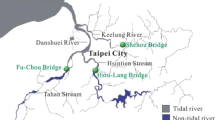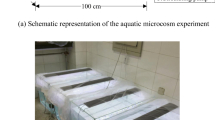Abstract
Hydrodynamic, physical, and biochemical processes in the Baiyangdian Lake water environment were analyzed comprehensively. An eutrophication ecodynamics model including the effects of reed resistance on flow was coupled with the hydrodynamics governing equations. An improvement on the Water Quality Analysis Simulation Program (WASP, a modeling system introduced by the US Environmental Protection Agency) is established, which uses the zooplankton kinetic equation. The model simulates water quality constituents associated with eutrophication in the lake, including phytoplankton, zooplankton, nitrogen, phosphorus, dissolved oxygen, and others. Various kinetic coefficients were calibrated using measured data or information from relevant literature, to study eutrophication in the lake. The values calculated by the calibrated model agree well with field data, including ammonia nitrogen, total nitrogen, total phosphorus and dissolved oxygen. Changes related to nutrition and dissolved oxygen during the processes were simulated. The present model describes the temporal variation of water quality in Baiyangdian Lake with reasonable accuracy. Deviations between model-simulated and observed values are discussed. As an ideal tool for environmental management of the lake, this model can be used to predict its water quality, and be used in research to examine the eutrophication process.
Similar content being viewed by others
References
Wen Z G. Crisis and solution on environmental protection for wetland of Baiyangdian Lake. Environment and Progress, 2003, 9: 33–35 (in Chinese)
Cui L T, Xu C X, Li Z W. Investigation and analysis of water environment in Baiyangdian. Journal of EMCC, 2005, 15(3): 59–61 (in Chinese)
Li J G. Study on water environment safety evaluation of Baiyangdian Lake Wetland. Dissertation for the Doctoral Degree. Baoding: Agricultural University of Hebei, 2005 (in Chinese)
Ma Z P, Jing A Q. A study on the water flow in Baiyangdian Lake. Acta Mechanica Sinica, 2004, 36(5): 589–595 (in Chinese)
Canu D M, Solidoro C, Umgiesser G. Erratum to “Modelling the responses of the Lagoon of the Lagoon of Venice ecosystem to variations in physical forcings”. Ecological Modelling, 2004, 175: 197–216
Cheng S T. Environmental System Analysis. Beijing: Chemical Industrial Press, 2006
Yang J K, Xiao B, Liu N F. Forecasting the influence of South-to-North Project on water quality in Xiangfan Section by using WASP6. China Water and Wastewater, 2005, 9: 103–104 (in Chinese)
Tufford D L, McKellar H N. Spatial and temporal hydrodynamic and water quality modeling analysis of a large reservoir on the South Carolina (USA) coastal plain. Ecological Modelling, 1999, 114(2–3): 137–173
Wang P F, Martin J, Morrison G. Water quality and eutrophication in Tampa Bay, Florida. Estuarine, Coastal and Shelf Science, 1999, 49(1): 1–20
Sun X C, Deng X L, Zhang C X. Application of WASP6 System on water quality simulation in Three Gorges Reservoir. Journal of University of Hydraulic and Electric Engineering, 2003, 2: 185–188 (in Chinese)
Chau K W, Jin H S. Depth-averaged, two-dimensional eutrophication modeling for Tolo Harbour, Hong Kong. Environmental Modeling and Assessment, 1999, 4(2–3): 189–199
Mukhopadhyay B, Bhattacharyya R. Modelling phytoplankton allelopathy in a nutrient-plankton model with spatial heterogeneity. Ecological Modelling, 2006, 198(1–2): 163–173
Chao X B, Jia Y F, Shields F D Jr, Wang S S, Cooper C M. Three-dimensional numerical simulation of water quality and sedimentassociated processes with application to a Mississippi Delta lake. Journal of Environmental Management, 2010, 91(7): 1456–1466
Wang X L, Lu Y L, He G Z, Han J Y, Wang T Y. Exploration of relationships between phytoplankton biomass and related environmental variables using multivariate statistic analysis in a eutrophic shallow lake: a 5-year study. Journal of Environmental Sciences (China), 2007, 19(8): 920–927
Wu T F, Luo L C, Qin B Q, Cui G, Yu Z, Yao Z. A vertically integrated eutrophication model and its application to a river-style reservoir-Fuchunjiang, China. Journal of Environmental Sciences (China), 2009, 21(3): 319–327
Liu Y, Guo H C, Wang L J, Dai Y L, Zhang X M, Li Z H, He B. Dynamic phosphorus budget for lake-watershed ecosystems. Journal of Environmental Sciences (China), 2006, 18(3): 596–603
Chau K W. A three-dimensional eutrophication modeling in Tolo Harbour. Applied Mathematical Modelling, 2004, 28(9): 849–861
Mao J Q, Chen Y C, Liu Z W, Chen Q W. Modelling studies on eutrophication process in Wulihu bay of Taihu Lake. China Environmental Science, 2006, 26(6): 672–676 (in Chinese)
Kuo J T, Hsieh P H, Jou W S. Lake eutrophication management modeling using dynamic programming. Journal of Enviromental Management, 88: 677–687 (in Chinese)
Liu X B, Peng W Q, He G J, Wang Y C. A coupled model of hydrodynamic and water quality for Yuqiao Reservoir in Haihe River Basin. Journal of Hydrodynamics, 2008, 20(5): 574–582
Rao Q, Rui X F, Xu Y H. Research of two-dimension eutrophication ecological dynamic model. Advances inWater Science, 2003, 14(6): 710–713 (in Chinese)
Arhonditsis G B, Brett M T. Eutrophication model for Lake Washington (USA) Part I. Model description and sensitivity analysis. Ecological Modelling, 2005, 187(2–3): 140–178
Mao J Q, Chen Q W, Chen Y C. Three-dimensional eutrophication model and application to Taihu Lake, China. Journal of Environmental Sciences (China), 2008, 20(3): 278–284
Cugier P, Megesguen A, Guillaud J. Three-dimensional (3D) ecological modeling of the Bay of Seine (English Channel, France). Journal of Sea Research, 2005, 54(1): 104–124
Li JW, Yang L H, Liang B C. The application of improved principal component analysis method to the water quality appraisement in Baiyangdian Lake. Haihe Water Resources, 2007, 3: 40–43 (in Chinese)
Hu W P, Jorgensen S E, Zhang F B. A vertical compressed three-dimensional ecological model in Lake Taihu, China. Ecological Modelling, 2006, 190(3–4): 367–398
Author information
Authors and Affiliations
Corresponding author
Rights and permissions
About this article
Cite this article
Wang, X., Zhang, S., Liu, S. et al. A two-dimensional numerical model for eutrophication in Baiyangdian Lake. Front. Environ. Sci. Eng. 6, 815–824 (2012). https://doi.org/10.1007/s11783-011-0383-6
Received:
Accepted:
Published:
Issue Date:
DOI: https://doi.org/10.1007/s11783-011-0383-6




